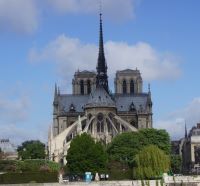 I am writing after a long and satisfying day in Paris, exploring and above all experiencing. In the morning, we went to Notre Dame to visit one of the most magnificent Gothic churches in the world. Constructed (literally)
I am writing after a long and satisfying day in Paris, exploring and above all experiencing. In the morning, we went to Notre Dame to visit one of the most magnificent Gothic churches in the world. Constructed (literally) 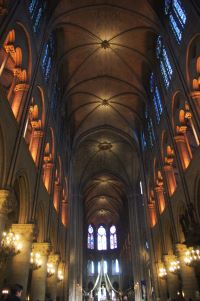 from the 12th through the 19th centuries, its flying buttresses and facades are so central to Gothic—and France—that distances in the country are literally measured from a spot in front of the Cathedral. We were there for the 10 am mass, which was performed with a Gregorian choir. The interior is relatively spare, but the stained glass windows and the height make it a picture story—say about the Hunchback of Notre Dame!
from the 12th through the 19th centuries, its flying buttresses and facades are so central to Gothic—and France—that distances in the country are literally measured from a spot in front of the Cathedral. We were there for the 10 am mass, which was performed with a Gregorian choir. The interior is relatively spare, but the stained glass windows and the height make it a picture story—say about the Hunchback of Notre Dame!
Professor Pana and I used the time between the mass and our next departure, for Versailles, to spend a little over an hour (about two hours too 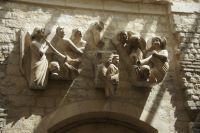
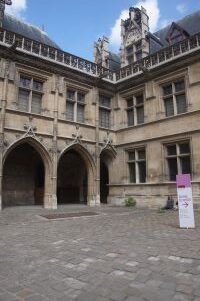 few) at the nearby Museum of the Middle Ages, better known perhaps by its former location as the home of the Abbots of Cluny. The most famous possessions of the Cluny—alas—the Lady and the Unicorn tapestries—were on loan to a museum in Tokyo, but the other relics, including some from Byzantium (the 4th crusade detoured from the Holy Land to Byzantium and ransacked the city, stripped the empire of a number of possessions –and goodies, such as the horses of St Mark, now in Venice after having been “borrowed” by Napoleon for the Arc de Triomphe) that really are works of art. In addition, the Cluny sits on what was a Roman bath in the first century BC, a testimony to the lengthy history of settlement on the banks of the Seine.
few) at the nearby Museum of the Middle Ages, better known perhaps by its former location as the home of the Abbots of Cluny. The most famous possessions of the Cluny—alas—the Lady and the Unicorn tapestries—were on loan to a museum in Tokyo, but the other relics, including some from Byzantium (the 4th crusade detoured from the Holy Land to Byzantium and ransacked the city, stripped the empire of a number of possessions –and goodies, such as the horses of St Mark, now in Venice after having been “borrowed” by Napoleon for the Arc de Triomphe) that really are works of art. In addition, the Cluny sits on what was a Roman bath in the first century BC, a testimony to the lengthy history of settlement on the banks of the Seine.
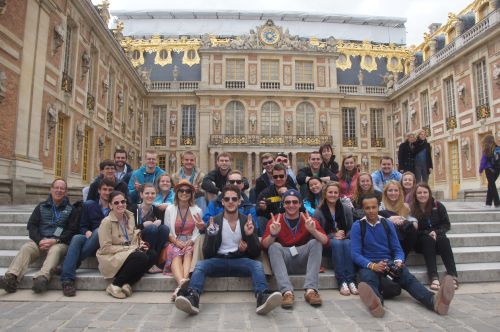 We spent the afternoon at the Chateau of Versailles, begun as a modest hunting lodge for Louis XIII, but expanded by his son, the Sun King Louis XIV, to become the premier castle, and I believe the largest, certainly in Europe, and one that puts Windsor Castle into the minor leagues. The world class attraction seemed to have attracted the world this Sunday, as the rooms were as crowded as could be. 46,000 workers labored to bring the finest the French monarchy could obtain to the Chateau. It came close to bankrupting France, a process that culminated, when the spending to fight Britain and incidentally help the US gain independence, precipitated the French Revolution. In the meantime, the Bourbon kings (XIV, XV, XVI—sounds like super bowls, don’t they) enjoyed the facilities. They say Louis XIV built it, XV enjoyed it, and XVI paid for it. We had a lively discussion involving those who have traveled elsewhere in Europe, and the closest rivals we could come up with were St. Petersburg—and the Vatican St. Peters.
We spent the afternoon at the Chateau of Versailles, begun as a modest hunting lodge for Louis XIII, but expanded by his son, the Sun King Louis XIV, to become the premier castle, and I believe the largest, certainly in Europe, and one that puts Windsor Castle into the minor leagues. The world class attraction seemed to have attracted the world this Sunday, as the rooms were as crowded as could be. 46,000 workers labored to bring the finest the French monarchy could obtain to the Chateau. It came close to bankrupting France, a process that culminated, when the spending to fight Britain and incidentally help the US gain independence, precipitated the French Revolution. In the meantime, the Bourbon kings (XIV, XV, XVI—sounds like super bowls, don’t they) enjoyed the facilities. They say Louis XIV built it, XV enjoyed it, and XVI paid for it. We had a lively discussion involving those who have traveled elsewhere in Europe, and the closest rivals we could come up with were St. Petersburg—and the Vatican St. Peters.
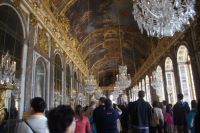 The best features inside might well have been the Hall of Mirrors, where in 1919, the Allies imposed the Treaty of Versailles on the Germans. Other treaties ending the war against other central powers also occurred on the property—Hungary was divided (“The Worst Treaty in History,” intoned our guide in Budapest three years ago!) at Trianon, for example. The lavish decorations at similar palaces always make me wonder why it took over 3 centuries for the Revolutions to occur!
The best features inside might well have been the Hall of Mirrors, where in 1919, the Allies imposed the Treaty of Versailles on the Germans. Other treaties ending the war against other central powers also occurred on the property—Hungary was divided (“The Worst Treaty in History,” intoned our guide in Budapest three years ago!) at Trianon, for example. The lavish decorations at similar palaces always make me wonder why it took over 3 centuries for the Revolutions to occur!
The overall best features, however, might well have been the outside gardens, 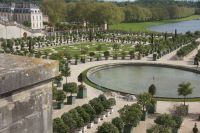 which did not have the crowds, but did have landscape and solitude. The outside has been restored since I was last here, and one of the features, the Bath of Apollo, looked for all the world like something on the Canadian shield I had portaged until I saw the statuary; that wasn’t me schlepping a canoe, though come to think of it…..
which did not have the crowds, but did have landscape and solitude. The outside has been restored since I was last here, and one of the features, the Bath of Apollo, looked for all the world like something on the Canadian shield I had portaged until I saw the statuary; that wasn’t me schlepping a canoe, though come to think of it…..
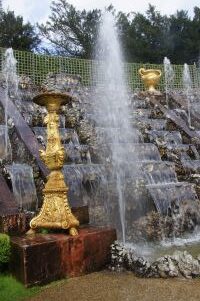 I was thinking, “I’ve seen it all” when a newly-resurrected waterfall appeared as we turned a corner. We were lucky because for two and a half hours a day, water flows and falls in the gardens and period classical music gets piped over the loudspeaker.
I was thinking, “I’ve seen it all” when a newly-resurrected waterfall appeared as we turned a corner. We were lucky because for two and a half hours a day, water flows and falls in the gardens and period classical music gets piped over the loudspeaker.
While Peter the Great would love to have duplicated Versailles at the Peterhof, and the Hungarians, Indochinese, and French in China would love to have been the Paris of the East, or a second Paris, when you come here, you’ll understand why I think there’s only ONE Paris!